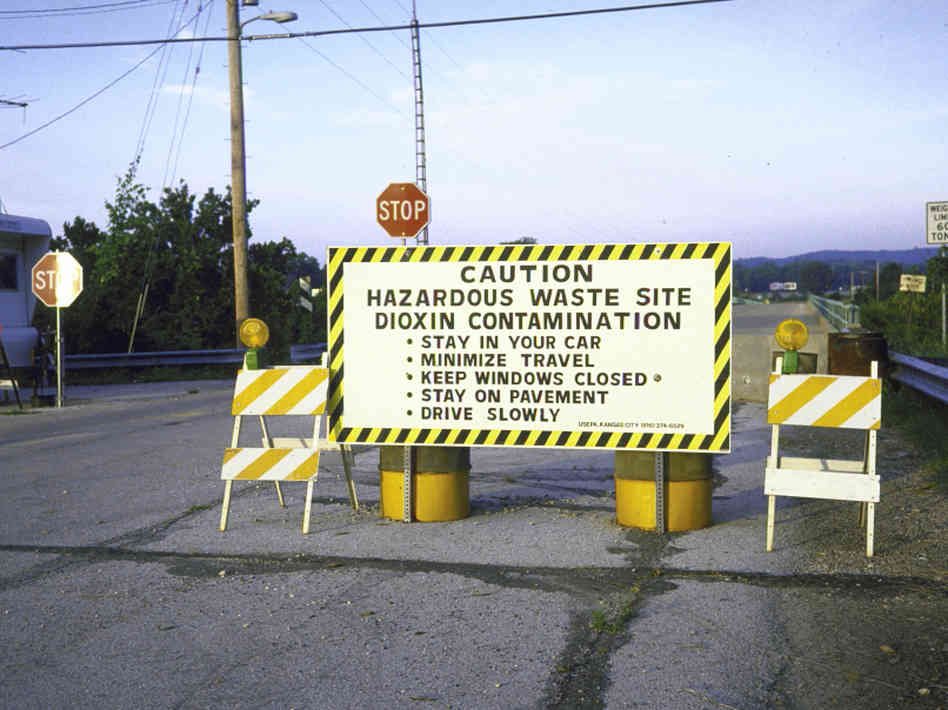Paved With Good Intentions
In 1925, a newspaper called the St. Louis Star-Times came up with a strange promotion. They secured a relatively large area of land about 15 to 20 miles (roughly 27 km) southwest of St. Louis in the floodplains of the Meramec River. The paper then sold off plots of land measuring 20 by 100 feet (6 m by 30 m) for $67.50 — about $900 today, accounting for inflation. Land wasn’t all one received, though, as a purchaser was also entitled to a six-month subscription to the Star-Times.
Whether the promotion was successful, though, is a matter of perspective. The land turned into a small town, home to about 2,000 people, starting off as a summer getaway for St. Louis’s elite, but soon after World War II fell on tough times, and became mostly low-income housing. The Star-Times itself folded in 1951, but the town it founded persevered on.
Until 1985 — when it was evacuated, because the roads were literally toxic.
Times Beach, Missouri’s end began in the 1970s. Being relatively poor, it lacked the funding to pave most of its roads. The dirt roads led to dust storms, as high winds would catch loose dirt, blowing it around to the menace of virtually everyone. At the time, the standard solution for such a malady was to spray the roads with oil; the oil would cause the dirt to clump together, making it tough for the wind to blow it around. While this treatment sounds like a horrible idea to modern ears, in general, it was bad, but not catastrophic. Times Beach was that catastrophic exception.
Why? Because Russell Bliss, the person hired to spray down the roads, bought his oil from a company which gave it to him cheaply — probably because they considered it toxic waste.
During the Vietnam War, the U.S. military employed the use of Agent Orange, an herbicide officially used to destroy forests and therefore remove the cover that the landscape provided to Viet Cong guerrillas. But Agent Orange contained a particularly toxic type of dioxin, and is likely responsible for serious maladies, birth defects, and even deaths of tens of thousands (if not a million or so) Vietnamese.
And the place Bliss got his oil from? Unbeknownst to him, it was one of the plants that made Agent Orange. The waste he was spraying down Times Beach’s roads with contained huge amounts of dioxin.

The oil spraying went on from 1972 to 1976 and for years after, went undetected. But in December of 1982, the Environmental Protection Agency (EPA) ran a test on some dirt samples, finding that the amount of dioxin was 100 times higher than what was considered safe for humans. Soon after, the EPA did something rare — it shut down the entire town. Everyone was evacuated, and for all intents and purposes, Times Beach, Missouri, ceased to exist.
The federal government did not just order people to leave, though; it also stepped in to compensate them for their homes and everything else that had to be left behind (here’s one article about it, in Australia’s The Age; the international reach of the story underscores the severity and uniqueness of the pollution). By 1985, the town was entirely empty — even the power running into Times Beach was turned off. On the urging of the former town’s aldermen, then-Governor John Ashcroft de-incorporated the town. The town, as recounted by the Associated Press, turned into a modern-day ghost town. Those who drove into the area, after passing the sign pictured above, found what the town’s last mayor likened to “being in the middle of a science fiction movie.”
Today, the site has been rehabilitated and is believed to be safe (although the scientific community doesn’t know all that much about the risks from dioxin exposure). If you’d like, you can visit — it’s a state park commemorating the now-decommissioned Route 66.
Bonus Fact: Route 66 was originally designed, in part, “to test the feasibility of the use of camels as pack animals in the southwestern desert,” according to Wikipedia.
From the Archives: Eternal Vacancy: Another ghost town.
Related: The Route 66 Encyclopedia. 13 reviews, totaling a rare 5 full stars.
